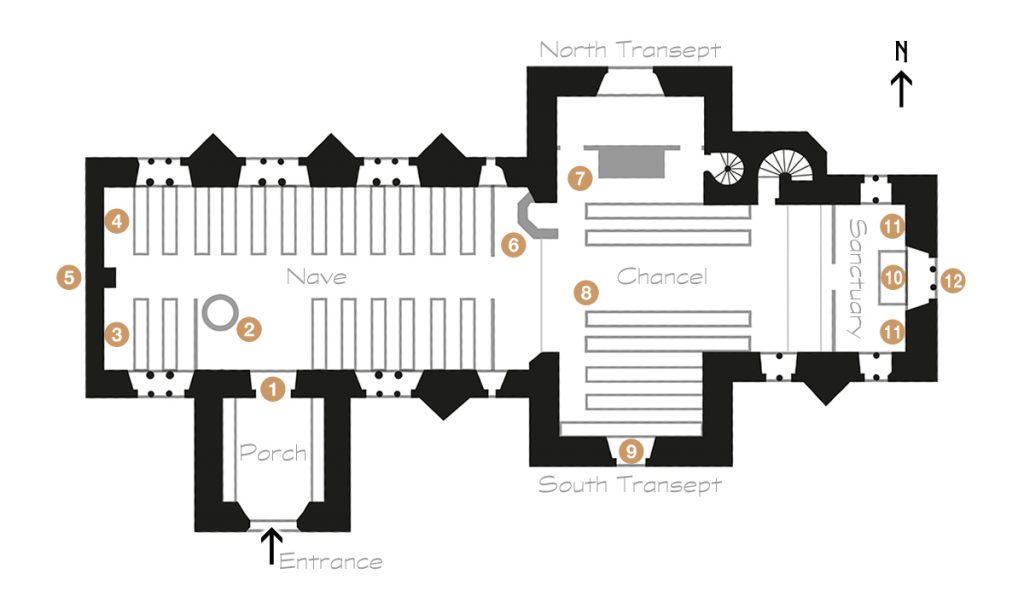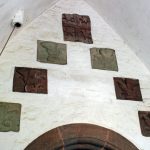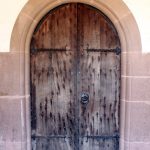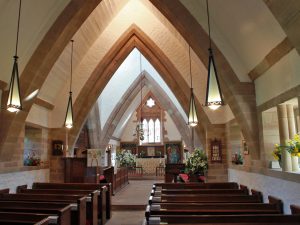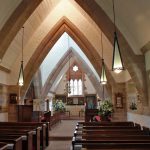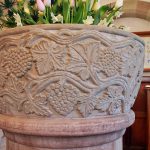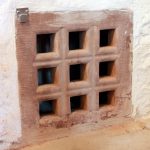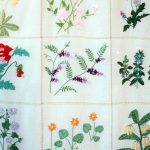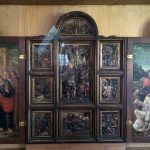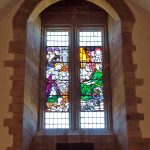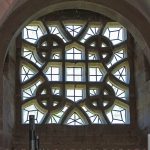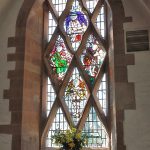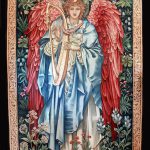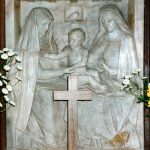Click the titles below to explore the inside of the church:
The Porch
The Porch
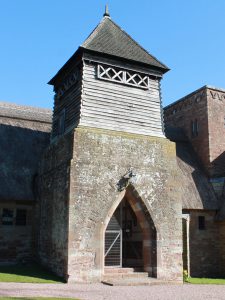
The south-facing porch is situated towards the highest point of the churchyard. A plain stone step with a semi-circular inset projects to welcome you. As you enter, look for the masons’ marks inscribed into the stonework of the entrance arch and on the inner archway.
The entrance porch is small, almost domestic, unlike many churches of this era. The warm Herefordshire sandstone contrasts with the white plastered and lime-washed rubble walls. The ceiling is lime-washed plaster on a concrete vault.
Above the inner doorway 1 are six doves of peace and a cross and stars, carved in contrasting local stone. At first glance the doves appear identical, but they are all strikingly different.
The double entrance doors are made of wide planks of English oak, studded with hand-made iron nails, and with beautiful plaited wrought iron hinges.
As you enter through the doorway notice how thick the walls appear; they are almost 150mm thicker than the rest of the building. This is an architectural trick to make the building seem more massive.
Close
The Nave
The Nave
The Crossing Tower
The Crossing Tower
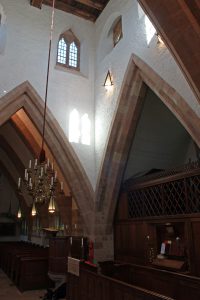 The transition from nave to chancel is dramatic, with eight clerestory windows of different patterns of stonework and tracery. At dawn, as first light enters and later in the day, there are some splendid lighting effects both here and in the nave and sanctuary. Together with the lime-washed walls, the effect is of illuminating the whole church and there is a striking contrast with the dark oak-beamed roof structure above.
The transition from nave to chancel is dramatic, with eight clerestory windows of different patterns of stonework and tracery. At dawn, as first light enters and later in the day, there are some splendid lighting effects both here and in the nave and sanctuary. Together with the lime-washed walls, the effect is of illuminating the whole church and there is a striking contrast with the dark oak-beamed roof structure above.
Close
The Transepts
The Transepts
The north transept houses the organ 7, which was built in 1903 by J W Walker and Sons Limited. The action and pipework is placed behind oak panels and a simple latticework, which gives a good resonant sound. The organ cost £512 to build. It was restored by the same firm in 2000 at a cost of over £58,000. Behind the organ is a spiral staircase leading to the tower roof.
Above the organ is the north window; an exceptional example of tracery. The design is thought to have originated from a diagram for the twelve heavenly houses to be found in Lethaby’s book “Architecture, Mysticism and Myth”.
The oak choir and clergy stalls 8 are delicately carved with forty eight panels depicting wild flowers. The carving is almost certainly the work of George Jack, teacher of woodcarving at the Royal College of Arts.
The south window 9 is a fine example of the work of the Christopher Whall studios. His work is particularly known for its richness colour and clarity of design. The window depicts an angel and three musicians with a memorial inscription to Ebenezer Jordan.
Close
The Sanctuary
The Sanctuary
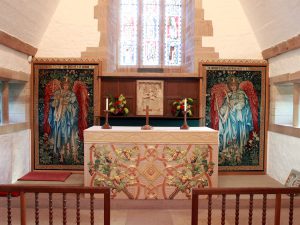 The stone slabbed floor extends through to the sanctuary 10 and the scale of the building becomes almost domestic again, similar to the porch. The north and south windows are simple in form, with a little more detail than those in the nave. There is a piscina A piscina is a shallow basin placed near the altar of a church used for washing the communion vessels. cut into the south window sill.
The stone slabbed floor extends through to the sanctuary 10 and the scale of the building becomes almost domestic again, similar to the porch. The north and south windows are simple in form, with a little more detail than those in the nave. There is a piscina A piscina is a shallow basin placed near the altar of a church used for washing the communion vessels. cut into the south window sill.
To either side of the altar are tapestries 11 made by the William Morris Workshops from designs by Edward Burne-Jones. The original design was produced in 1875 for a stained glass window in Salisbury Cathedral. The intricate details of these “Angeli Laudantes” were woven for Ebenezer Jordan in memory of his parents.
Behind the altar, set into the oak panelling, is a fine alabaster statue of the Madonna.
Above the altar, the east window 12 is the finest in the church. It consists of three lancets, surmounted by a six-pointed star, thought to be either the Star of Bethlehem or of David. Appropriately for a church dedicated to All Saints, there are seven saints and two angels within the lancets, with a wavy band in the stonework above, possibly indicating the sea of heaven beneath the stars.
There are two wall plaques on the north wall commemorating Arthur and Alice Foster. Next to the plaques is a door leading down to the vestry.
Close

